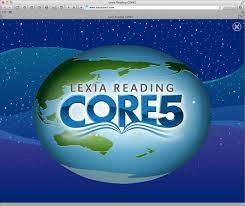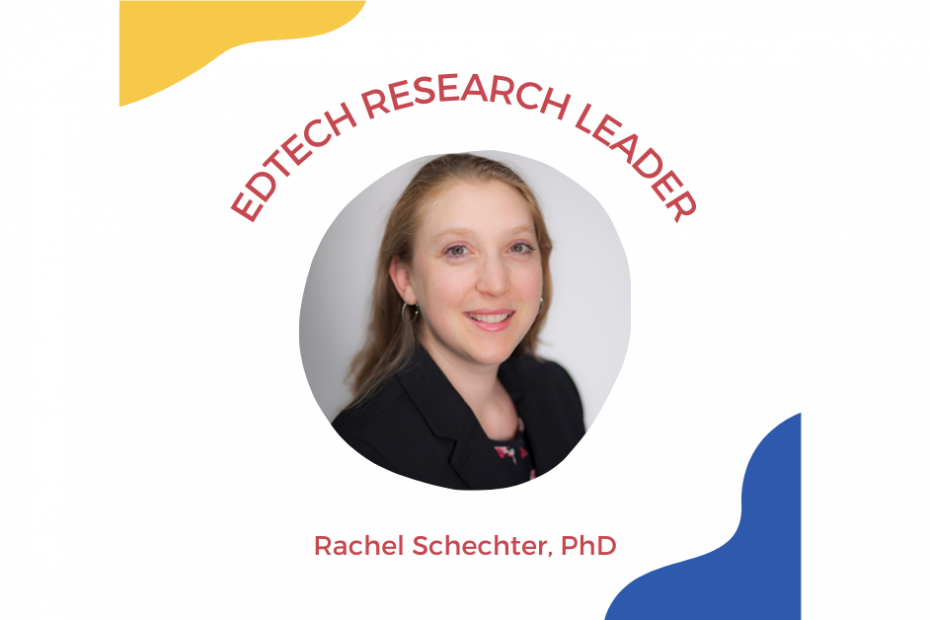In the following interview with founder Dr. Rachel Schechter, we learn how early experiences in research at Nickelodeon, leading innovative assessment development Lexia Learning, and infusing Learning Sciences across K-12 products at Houghton Mifflin Harcourt has uniquely positioned LXD Research as the research consultant that every edtech product needs today.

What prompted you to begin a career in Learning Sciences?
I was given a unique opportunity that helped me establish myself for my current business today. During undergraduate studies, I was fortunate to have Dr. Dan Anderson, who was involved in the creation of Blue’s Clues, and Dora the Explorer, as a professor. In 2000, I interned as a production and research assistant on the first and second seasons of Dora the Explorer. During that time, educational technology was primarily at home television. There’s no feedback from the TV to help producers confirm what the kids are learning. User testing was our only way to see if the stories were going to support, and help the kids learn.
Can you share how you discovered the effectiveness of the content for Dora the Explorer?
Inside the room where we tested the content for Dora the Explorer, we had a pop-up storybook version of the episode. We made small popsicle sticks with characters and read the story to the children. One of the critical moments at the start of the show is when Dora looks at the audience and asks them a question and the audience is supposed to respond enthusiastically.
For example, they’ll ask, “Do you like ice cream?” And the children respond, “Yes, I love ice cream!”
This particular episode was about a letter Dora received from her grandmother. The first question of the script was, “Do you like to get mail?” After we asked the question, the room went silent, not one kid said yes, which was the opposite of what we were going for. The kids left the room. I’m an intern in the back. I raised my hand and said, “I have an idea about the question. Four-year-olds don’t typically receive mail, but maybe they go to the post office with a family member. Why don’t we change the question to, do you like to go to the post office?”
They said, “Sure, let’s try it!” The second group of kids came into the room, and we asked them the question, ”Do you like to go to the post office?” They all screamed, “Yes! I like to go to the post office.”
I realized how empathy and testing their response to the lessons, improved their learning experiences for the show. User testing was vital!
Q. How did this experience impact your career path?
This experience fostered a passion for measuring efficacy and outcomes using research and analysis. Our user testing was vital for every Dora the Explorer episode. I received my BA in Psychology and a BA in Individual Concentration (BDIC), Child Development through Theater in Education at the University of Massachusetts. Later, I received my Masters in Education (EdM), Arts-in-Education at Harvard University. After teaching in the music world, I went back to school and completed my Doctorate of Philosophy (Ph.D.) and child development psychology at Tufts University.

How did you transfer your skill for user testing to educational technology?
During my Ph.D. training in 2010, I completed my doctoral internship at Goodman Research, which specializes in evaluating technology-focused programs. At this time, technology was becoming more interactive for an array of learning experiences. The internet and web-enabled technology were popular and affordable. This is where I applied my training to test how interactive web-enabled technology could enhance learning.
The project that turned the corner for me was the Black Holes exhibit at the Museum of Science in Boston. Students and scientists worked together to create games with technology-embedded assessments. As museum visitors played, they simultaneously gave us data to help us understand what they learned.
We evaluated the information and could see how many answered the questions correctly. This was very high-tech at the time. The greatest advancement was gaining the ability to access what they learned without them knowing. The technology-embedded assessments helped us to evaluate their learning outcomes and discover how to improve their instructional training.
How did embedded assessment contribute to online learning after you graduated?
I was hired at Lexia learning, a reading technology company that provides structured literacy solutions and professional learning to K-12 students at over 20,000 schools nationwide. Building on the power of embedded assessment, and accessing learning without the students knowing, was exactly how I brought value to Lexia’s online literacy programs. They wanted to build a system to assess students’ learning and reading skills, without testing them.
The Lexia curriculum transitioned from web-enabled, which is different from what gaming is today. The learning game initially didn’t respond to the children’s answers and had a straight path. I was able to transition the product into an interactive learning experience that was not only web-enabled but when the child completed the game, the data was sent back and forth. Before this time, when something was web-enabled in 2007, 2010, or even up to 2012, the data packet would be sent at the end. With better internet, stronger broadband, and advanced video graphics, by 2013, they could send a data packet every 90 seconds, not only to the server but as a response sent back to the game to tell the user what to do next.

How was this groundbreaking for its time?
This was a groundbreaking advance because it helped us measure children’s learning while they played, without feeling like an effort or a test they have to take. During the No Child Left Behind era, there was a negative feeling about testing because the number of tests in the classroom had tripled. This was super innovative for its time and changed online education and learning programs forever. I eventually became the Director of Research at Lexia and led a 12-member department and was involved in both the product development and the user testing and research aspect.
Why did you transition from Lexia Learning to Houghton Mifflin Harcourt (HMH)?
When I started as the Vice President of Learning Sciences at Houghton Mifflin Harcourt (HMH), I was ready to bring my technology experience to expand to a much larger company with more products, students, and disciplines. This was an opportunity to help HMH transition into the digital world. The technology at Lexia Learning was efficient and working. The systems were set up and HMH needed technological advancement. They were still evolving from selling physical textbooks to turning those textbooks into digital products.

HMH wanted to build an integrated system under all of its educational products so that the products could work together, and become technologically connected. My job was to create that data system and learning sciences framework, which I called RAMP, to “ramp up learning” at HMH. In order to help make the products better using technology, we aligned teams across disciplines around how the company approached social and emotional learning. The HMH products were initially separated. Integrating components of social and emotional learning into multiple products and integrating connections and commonalities, helped get all these boats to row in the same direction.
Our team set a collaborative vision, added cohesive terminology, and a methodized approach to teaching the curriculum. We combined a common set of skills across all products, so the products were taught the same way among different subjects. The language was cohesive and followed similar implementation protocols and became known as HMH-connected solutions.
What caused you to transition into your own business?
During my first year at HMH, in the winter of 2019, the national assessment report for academic, and educational progress in the United States came out. The report showed 20 years of stagnant reading progress in basic math and reading. I read a controversial article called, Why Are We Still Teaching Reading the Wrong Way written by Emily Hanford, who stated that the reason the reading assessment report is stagnant is that we’re teaching reading wrong. This new awareness was a personal and professional turning point for me. During my informative professional years at Lexia, we lived the motto we were teaching reading the right way because it was backed by research. The progress report had me contemplating how I can use my experience to further impact this problem.
Covid was also a contributing factor. When the pandemic hit, it was the first time in history that American schools were closed for an extended period. At the beginning of Covid, I was assigned to write a paper for HMH to guide schools on how to get through the pandemic. For this project, my team and I created the framework for how the K-12 American education institutions could recover. The paper was an integration of all of the years of learning, building knowledge, and expertise — a synthesis of what the country needed to support the teachers and the youth of America during these times.
After completion, the overwhelming needs of the country hit me hard. I remember thinking, how can I make a greater impact on education? I began to do market research to discover the challenges of education technology companies. I messaged leaders across the country, scheduled meetings, and gathered needs by understanding their challenges.
How did LXD Research come to fruition?
After doing extensive market research, we discovered educational companies had needs without research plans to solve them. After decades of experience in the educational technology realm, we discovered we are agile toward creating data-driven solutions for educational tech companies and districts. External evaluation is valued and required by stakeholders. Serving an array of clients, we primarily work with educational technology product leaders to design research plans that provide a deep understanding of product/program implementation, teaching impact, and learner outcomes.
How does LXD Research provide value in today’s landscape?
Each wave of innovation and industry growth shows agility that reflects the services LXD Research provides for customers today. Our value to our customers comes from a culmination of all of the experience cultivated since conducting user research during Dora the Explorer days, to being on the cutting edge of embedded assessment, and to utilizing technology to connect products that impact millions of children nationwide. Each technological advancement has contributed to industry progression ranging from the No Child Left Behind Act and the importance of embedded assessment to eliminating testing. To the evolution of textbook products to online digital platforms, and the significance of proving efficacy and evidence for educational products under the ESSA law of today.
At Learning Experience Design (LXD) Research, we partner with edtech companies around the globe to conduct a rapid-cycle evaluation that not only provides the efficacy research needed under the Every Student Succeeds Act law, but also informs the interactive improvement of products used by tens of millions of children worldwide. Simultaneously, since the formation of LXD Research we’ve seen our consulting guidance boost the capacity for education leaders to buy research-proven products, giving the sales teams leverage to assure the investment will accelerate learning for students of all abilities. In contrast to typical tactical research, we are shaping the national discourse about what “research-based” and “evidence-proven” really mean.
To listen to Rachel tell her story, check out her episode on the Disrupting Education Podcast
